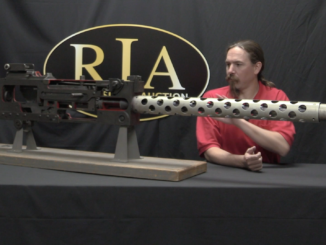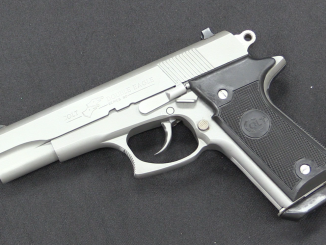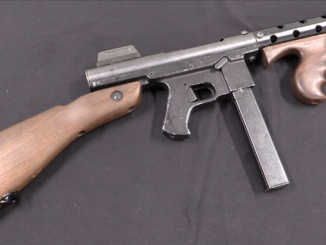This is Lot 1106 in the upcoming October 2019 Morphys Extraordinary auction.
The Marlin / United Defense US-42 submachine gun was not used by the American military, but it did see service in World War Two. Its 9mm chambering made it inconvenient for the US, but ideal for agencies like the OSS and SOE to drop to resistance organizations within occupied Europe. So, let’s take this one to the range and see what those resistance fighters were actually getting…




All we need now is a method of hiding it on your person (or perhaps just use a violin case) so that you can pull a “Surprise, suckers” on occupation troops. Just kidding!
I have a copy of the book “Ill Met by Moonlight”, which recounts how British forces, aided by Cretan patriots, captured a German general during the war.
Many of the Cretans were armed with Marlin guns, which they liked very much. Some can be seen in the photos in the book.
Cretans are very proud people, who love independence and guns almost equally. Although Greece has gun control, they do not seem to apply it very strongly in Crete, where many people still own wartime guns. I can guarantee that none of those Marlin guns will have been handed over to the authorities at the end of the war. The men who fought with them will have kept them, and passed them down.
The Cretan point of view is that you never know when the Turks might return, and it is best to be prepared for them.
On a side note, I must congratulate Ian for his natty choice of headgear. I wonder if he bought his tweed cap on his recent trip to Leeds?
“(…)German general(…)”
Generalmajor Kreipe or to give full name Karl Heinrich Georg Ferdinand Kreipe
https://en.wikipedia.org/wiki/Heinrich_Kreipe
interestingly:
…Kreipe met his kidnappers one more time in 1972 on a Greek television programme.
This is probably one of the only successful kidnappings of commanding officers during wartime. To be fair, nobody expected such a thing to happen.
The SOE operation where two agents went undercover to abduct the Crete garrison commander is also recounted in the 1988 book Clandestine Warfare.
“(…)Marlin / United Defense US-42 submachine gun was not used by the American military, but it did see service in World War Two.(…)”
And World part of War Two manifested in it, as it was designed by Gus Swebilius
https://guns.fandom.com/wiki/Gus_Swebilius
who was born in Sweden, was originally ordered by Dutch and even shipped to Dutch East Indies https://modernfirearms.net/en/submachine-guns/u-s-a-submachine-guns/ud-m42-eng/ was produced by High Standard and Marlin (hinting that sole producer had not enough free power for given demand), was named United Defense (UNITED like in https://digital.library.unt.edu/ark:/67531/metadc414/ ), was delivered to resistance across Europe.
United Defense was a US government shell corporation created to avoid corporate competition over patents deemed necessary for the war effort. Thus design rights that had been purchased outright by the government were held by United Defense and manufacturing contracts were let out to any and all private companies as were needed to get the job done. It’s still around I think, holding rights to M60 machine guns and M113 APCs and the like.
“(…)Marlin UD-42 SMG(…)”
Related patent US2289067A Box-magazine for firearms
https://patents.google.com/patent/US2289067?oq=US+2289067
One of my favorites!
I once read a book by a U.S. OSS operative, a Greek American, who went to Greece to work with the partisans. I thought from the photographs that he must have delivered a lot of these UD42 9mm SMGs, given that they appear in the hands of many in the photos… On closer examination I realized it was the same pair of high-value U.S.-supplied SMGs that the chieftains and andartes would pose with the same pair! The Greek Communist Party group he was with had a number of Ukrainian HiWis from the German occupation army defect to them as it became clear that the Soviets would soon hive off Rumania from the Axis, and be joined by Bulgaria, followed by a precipitous German pullout of the Balkans. The andartes could not trust these men, so they used them as a labor battalion.
Incidentally, Ian’s predecessor Timothy Mullin highly rated the “Marlin” 9mm United Defense 42 in his hands on experimental archaeology of submachine guns and other small arms.
The 9mm UDI magazines will fit a Thompson perfectly so if you made a 9mm TSMG
you could use these
I know all literature on the UD M42 says mag capacity is 20 rounds, but in reality they hold 25.
An interesting and distinctive-looking weapon. It appears to be a simple and solid design.
I wonder if a semiautomatic clone would be a viable project?
From the Record of Developmental and Experimental Ordnance Vol. 17, The Sub-Machine Gun (Wash. D.C.: Office of the Chief of Ordnance, Research and Development Service, n.d.), IF 16 (Note: the UD42 9mm was referred to as the Hi-Standard during the Aberdeen tests).
“HI-STANDARD–The first model of the Hi-Standard submachine gun was inspected and informally tested at Aberdeen Proving Ground on 28 and 29 August 1940 [i.e. before U.S. entry into WWII]. It was a cal. .45 weapon weighing 8.75 pounds and measuing 33.1 inches overall.
In the functioning tests the Hi-Standard handled more easily than the Thompson, M1928A1, and was of simpler construction. The cyclic rate of 900 rounds per minute was high and there was no provision for a magazine of more than 20 rounds capacity.
Further tests were recommended and the gun was returned to the manufacturers who submitted a second model (Fig. 12) on 12 November 1941. The gun was formally tested at Aberdeen Proving Ground on 24 and 26 November 1941. A 40-round magazine accompanied the weapon but could not be used because the forestock had been moved about 1.5 inches to the rear to provide a more convenient grip in prone firing. The average cyclic rate–880 rounds per minute–was only slightly lower than that of the earlier model.
Fired for accuracy from the machine rest at 100 yards the Hi-Standard showed the following average dispersion for ten shots on each of three targets:
Semi-automatic fire …. 5.38″ EHD 6.37″ EVD 6.67″ ES
Full-automatic fire …. 5.27″ EHD 6.28″ EVD 6.97″ ES
Those figures compare favorably with the extreme spread of 10.56 inches and 10.93 inches obtained with the Thompson, M1928A1, in semi-automatic and full-automatic fire at the same range. The figures are given only for comparison. The guns were not fired in competition one with the other.
Accuracy in semi-automatic fire was tested from the offhand position. Ten shots were fired at each of five targets at 100 yards. Analysis of the 50 shots showed:
Hi-Standard …. 11.10″ EHD 15.60″ EVD 17.30″ ES
Thompson M1928A1 .. 9.82″ 10.24″ EVD 12.36″ ES
Ten shots were fired offhand at each of ten targets at 50 yards. The Hi-Standard consistently placed from four to nine shots of each burst on the 6’x6′ target and was reported to handle comparatively well. The Thompson averages from three to seven hits under similar conditions.
DUST TEST–The Hi-Standard functioned perfectly after being exposed to agitated dry cement in a closed container. Both dusty and clean magazines were used and the gun handled both equally well.
MUD TEST–The gun fired three rounds after immersion in thin mud, then functioned faultily. Because of the large amount of grit which had penetrated to the chamber the bolt either failed to close or–if it closed sufficiently to fire the round–failed to eject the fired case. The chamber was cleaned and a full 20-round magazine was fired without malfunction. The Thompson could not be fired after immersion in mud.
Conclusions reached as a result of the tests of the Hi-Standard gun were that its accuracy from machine rest was good in comparison with the Thompson M1928A1; its accuracy from the offhand position, full-automatic, was very good in comparison with the Thompson M1928A1, and excellent in comparison with the Reising gun. Accuracy was rather poor when fired offhand, semi-automatic. The gun’s functioning was excellent under adverse dust conditions, good under escessive mud.
General functioning was good. The only common malfunction was that of firing doublets in semi-automatic operation. This appeared to be due to the rather inferior quality of the sear spring which took a permanent set after several hundred rounds. The gun was well balanced and well made. The recoil was light and there was little tendency to climb in full-automatic fire. No muzzle brake was used.
Six Hi-Standard guns were distributed among the Infantry Board, Cavalry Board, and Armored Force Board. Limited service tests indicated that further development was necessary before the weapon would meet the requirements of those Arms. The classification of the M2 as Substitute Standard halted further tests of the Hi-Standard gun.”